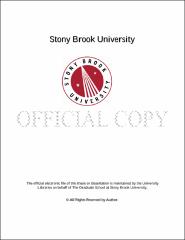| dc.identifier.uri | http://hdl.handle.net/11401/76435 | |
| dc.description.sponsorship | This work is sponsored by the Stony Brook University Graduate School in compliance with the requirements for completion of degree. | en_US |
| dc.format | Monograph | |
| dc.format.medium | Electronic Resource | en_US |
| dc.language.iso | en_US | |
| dc.publisher | The Graduate School, Stony Brook University: Stony Brook, NY. | |
| dc.type | Thesis | |
| dcterms.abstract | Air conditioning, space heating, and water heating makeup the largest proportion of building energy use in the U.S., making this segment an enormously rich opportunity for energy and cost savings. Devices like Vuilleumier Heat Pump (VHP), which can provide space heating, cooling and water heating at the same time, have very high efficiency compared to conventional air conditioners, space heaters and water heaters available in the market. The heat exchangers of a VHP play a significant role, and it affects the performance of a VHP significantly. Multi-Objectives such as reducing the pressure drop and dead volume of the working fluid in the heat exchangers should be considered while designing. The primary objective of this thesis is to develop an optimization tool using Teaching-Learning based optimization (TLBO) algorithm, which considers minimizing dead volume and pressure drop as the objectives. A design process starts by assuming some random desired values for few unknowns and evaluating the rest of the parameters based on those assumptions. But, quite often, it is apparent that, as the design is refined, there might be a huge difference between initially assumed values and current design parameters. This process consumes time, effort and resources. As an alternative, implementation of optimization techniques such as TLBO over the design variables in a specified range, which can give a set of optimal solutions in very less time, is discussed in this thesis. This work shows the application of TLBO and the process of converging to an optimal solution. The results obtained by implementing TLBO for a VHP heat exchanger are then compared to the existing design. A tool like this can be used at the start of design process so that lot of time and resources can be saved in the development cycle. | |
| dcterms.available | 2017-09-20T16:50:15Z | |
| dcterms.contributor | Mamalis, Sotirios | en_US |
| dcterms.contributor | Longtin, Jon P | en_US |
| dcterms.contributor | Wang, Lin-Shu. | en_US |
| dcterms.creator | Gadiraju, Siddhartha | |
| dcterms.dateAccepted | 2017-09-20T16:50:15Z | |
| dcterms.dateSubmitted | 2017-09-20T16:50:15Z | |
| dcterms.description | Department of Mechanical Engineering. | en_US |
| dcterms.extent | 55 pg. | en_US |
| dcterms.format | Application/PDF | en_US |
| dcterms.format | Monograph | |
| dcterms.identifier | http://hdl.handle.net/11401/76435 | |
| dcterms.issued | 2014-12-01 | |
| dcterms.language | en_US | |
| dcterms.provenance | Made available in DSpace on 2017-09-20T16:50:15Z (GMT). No. of bitstreams: 1
Gadiraju_grad.sunysb_0771M_11906.pdf: 2377389 bytes, checksum: d39b684868cd77c93eeedc6d54ab056d (MD5)
Previous issue date: 1 | en |
| dcterms.publisher | The Graduate School, Stony Brook University: Stony Brook, NY. | |
| dcterms.subject | Engineering | |
| dcterms.subject | constraints, Heat Exchanger, Multi-Objective Optimization, Optimization, Teaching-Learning Based Optimization, Vuilleumier Heat Pump | |
| dcterms.title | Optimization of Heat Exchanger in Vuilleumier Heat Pump Using Teaching-Learning Based Algorithm | |
| dcterms.type | Thesis | |

